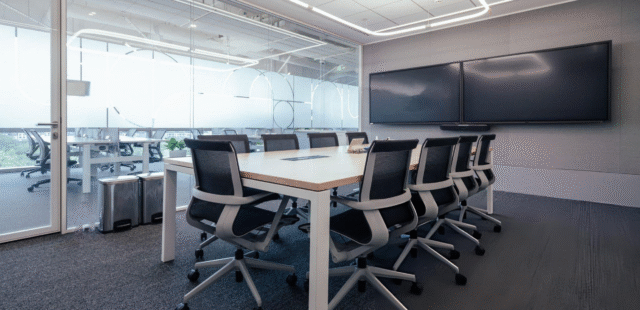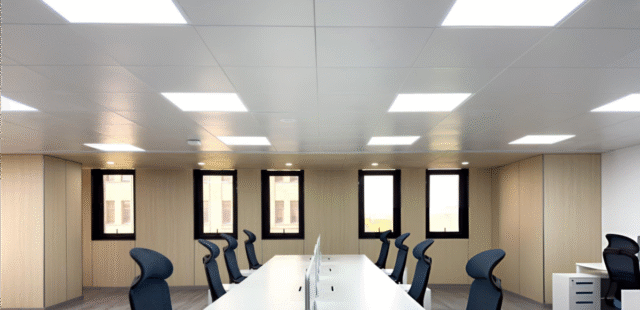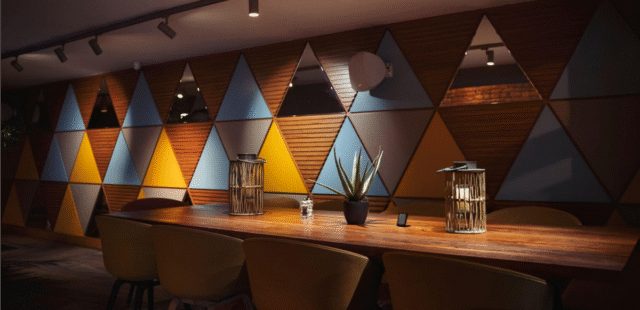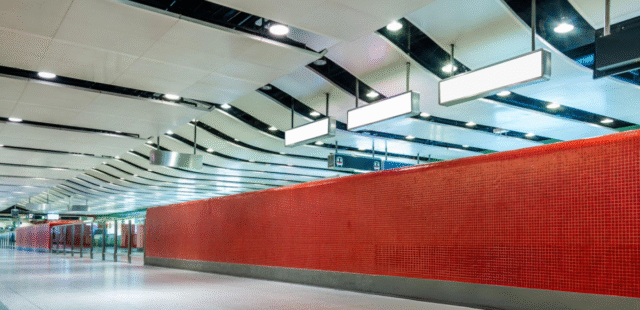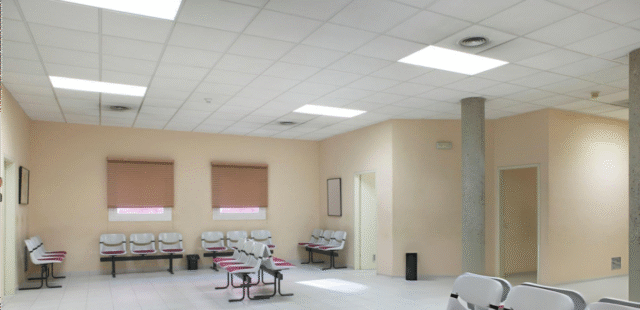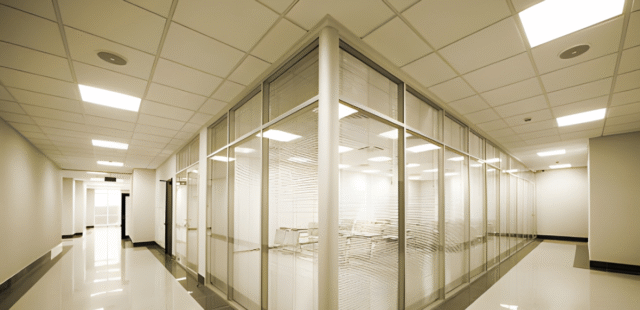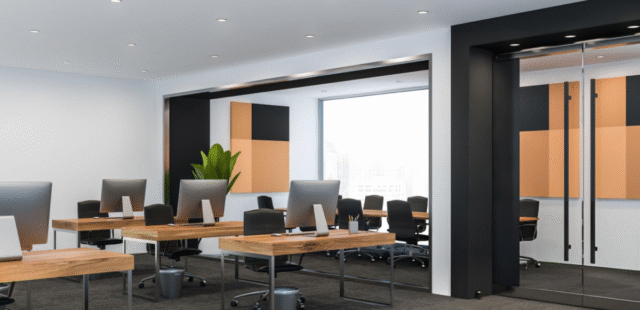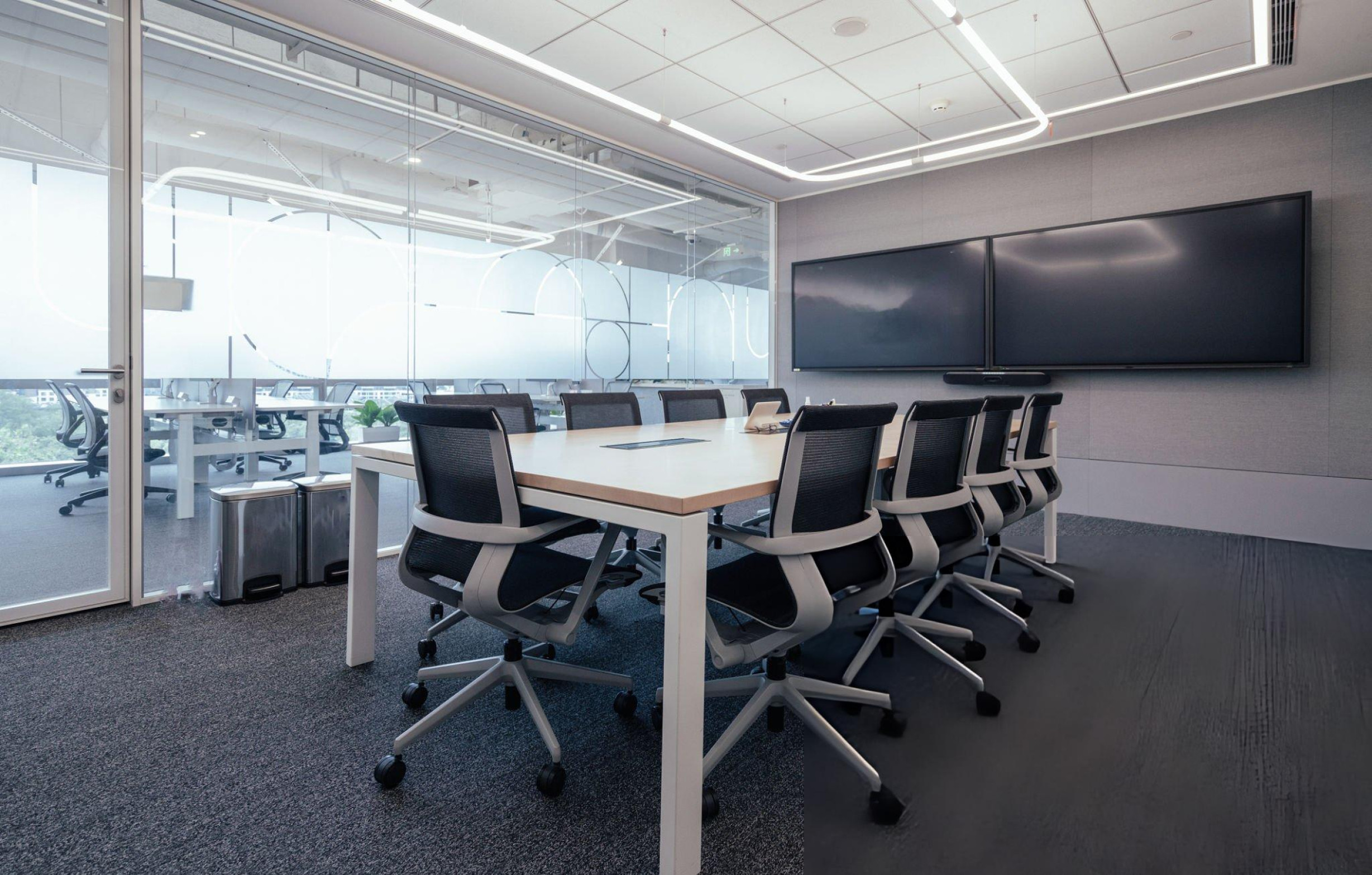
Modern environments, be it offices, educational institutions, hospitality venues, or public spaces, face unique acoustic challenges. Open layouts, extensive use of glass, and hard surfaces contribute to excessive reverberation and noise, severely compromising comfort, productivity, and privacy. As a result, effective sound absorption and precise acoustic management have never been more important.
Enter Amazone by Furnitech, a leader in the Indian sub-continent’s acoustic solutions market. With an extensive range of high-performance acoustic products tailored to diverse noise control needs, their Fibre Glass Wool Acoustic Panels have emerged as a preferred choice among architects, designers, and end users. These panels promise more than superior acoustics; they combine design versatility, product quality, and a focus on sustainable building.
Fibre Glass Wool Acoustic Panels are a lightweight, porous, elastic material composed of interlaced glass fibres. Its microstructure is engineered for excellent sound absorption: sound waves entering the fibre structure are effectively trapped and dissipated, significantly reducing echo and background noise. The inherent properties of these panels ensure high Noise Reduction Coefficient (NRC) values, providing effective control over mid to high frequency sounds.
For Fabric-Wrapped Fibre Glass Wool Acoustic Panels (for instance, 1200x600mm with 25mm thickness), NRC values can reach up to 0.95, providing exceptional performance in challenging acoustical environments. In contrast, ceiling tile variants such as 595x595mm, 20mm thick, offer NRC values of up to 0.70, making them suitable for general ceiling applications where moderate sound absorption is desired. This differentiation ensures that architects and end-users can select the right product for specific needs and sector requirements.
This makes Fibre Glass Wool Acoustic Panels ideal for a wide spectrum of applications where clarity, speech intelligibility, and comfort are essential, such as conference rooms, Dubbing Studios, classrooms, Home Theatre, Railway Waiting Rooms, auditoriums, Retail Stores, Voiceover Rooms and collaborative workspaces.
Amazone by Furnitech’s Fibre Glass Wool Acoustic Panels stand out for their:
Superior Sound Absorption Capabilities: Achieve NRC values of up to 0.95 in select fabric-wrapped variants, and up to 0.70 in ceiling tile and other variants, allowing clients to tune solutions based on acoustic priorities.
Lightweight and Durable Construction: The panels are easy to handle, install, and modify, yet are built to last in commercial and public spaces.
Breathability and Thermal Insulation Benefits: Their open fibre structure not only absorbs sound but also offers a degree of thermal insulation, contributing to greater energy efficiency and occupant comfort.
Performance and Quality Focus of Amazone by Furnitech
Acoustic Performance Standards and Certifications
Amazone by Furnitech’s acoustic solutions are manufactured in compliance with the highest industry standards, ensuring reliable and consistent performance. Our fabric-wrapped variants achieve NRC values up to 0.95, and ceiling tile panels delivering NRC ratings up to 0.70. These results meet and often surpass commercial benchmarks for applications in offices, learning centres, and hospitality venues.
Quality Control and Material Excellence
Quality forms the bedrock of Amazone By Furnitech’s offering. Each Fibre Glass Wool Acoustic Panel we supply passes through strict quality control protocols. This commitment minimises variability, ensuring every panel lives up to promised acoustic specifications and finish standards, which is especially critical for large-scale and prestigious projects.
Long-Term Durability and Maintenance
Durability is integral to Amazone By Furnitech’s product philosophy. Fibre Glass Wool Acoustic Panels are engineered for resilience against sagging, moisture, and impact, and retain their performance characteristics over years of use. Their low-maintenance nature means panels are easy to clean, contributing to lower lifecycle costs and greater customer satisfaction.
Design Flexibility and Customisation Options
Custom Sizes, Shapes, and Edge Profiles
One of the hallmarks of Amazone by Furnitech is their deep commitment to customisation. Fibre Glass Wool Acoustic Panels are available in multiple standard sizes, such as 1200 x 600 mm, 2100 x 600 mm, 600 x 600 mm, and 1800 x 600 mm with 25 mm thickness and the other variants such as 595 x 595 mm, 1195 x 295 mm and 1195 x 595 mm with 15, 20 and 25mm thickness. Clients frequently request and receive bespoke dimensions to suit project needs. Edge profiles such as Square, Tegular, and Microlook can be chosen to suit ceiling or wall integration preferences, supporting precise alignment with architectural details.
Range of Finishes and Colours for Aesthetic Integration
Amazone By Furnitech offers panels in contemporary colours such as black and white, suitable for a variety of interior schemes. For Fabric-Wrapped Acoustic Panels, options extend to a broad palette of jute fabric colours or colours as supplied by the client, allowing for alignment with project brands and aesthetics. This capacity for colour customisation ensures the panels visually integrate into any interior design vision.
Tailoring Panels to Specific Acoustic Requirements
Acoustic challenges differ from project to project. Amazone By Furnitech offers guidance and panel variants tailored to the absorption characteristics demanded by each environment, be it preventing cross-talk in an open office or achieving high speech intelligibility in a classroom. This bespoke approach means no compromise between design intent and acoustic excellence.
Enhanced Acoustic Solutions Offered
Amazone by Furnitech’s Acoustic Ceiling Clouds are available primarily in white fibreglass, and also in polyester fibre upon request. They come in ready-made sizes such as 1200 x 1200 mm, 1200 x 600 mm and 2700 x 1200 mm with 30mm and 40mm thickness. These panels can be manufactured in creative shapes, including circles, hexagons, rectangles, squares, waves, and curves, offering designers broad creative control to merge acoustic performance with visual interest. Mounted at strategic heights, clouds capture sound from multiple directions, efficiently countering noise in open or large-plan environments.
Amazone By Furnitech’s Acoustic Baffles are fabricated from fibreglass and polyester fibre and are available in standard sizes such as 2400 x 300 mm with 30mm thickness. Specifically designed for challenging open or complex spaces, such as large halls, airports, or industrial environments, where horizontal panels may not be practical. Suspended vertically, these baffles disrupt noise propagation paths, creating acoustic zones and reducing reverberation without compromising ceiling accessibility or lighting.
Acoustic Panels, such as Fabric Wrapped Acoustic Panels from Amazone By Furnitech are available in fibreglass wool options. They combine high sound absorption with convenience and style. Available in custom sizes, thicknesses, and a variety of fabric colours (including jute fabric and client-supplied materials), they seamlessly integrate with other decor elements, serving dual functions: reducing noise and enhancing interior ambience. The lightweight yet robust construction allows secure mounting on any wall, making them suitable for boardrooms, theatres, cafes, and more.
Eco-Friendly Construction and Sustainability
Recyclability and Low Environmental Impact Manufacturing Processes
Amazone By Furnitech’s panels are engineered to be recyclable at end-of-life, supporting a circular-economy approach. The manufacturing processes are optimised to minimise emissions, waste, and resource use, with low emissions recorded during panel manufacturing, thereby reducing the ecological footprint of each project.
Use of Environmentally Responsible Materials
Sustainability is central to Amazone By Furnitech’s ethos. Our fibreglass wool products are considered safe and eco-friendly materials, incorporating responsibly sourced content that promotes healthier indoor air quality.
Contribution to Green Building Certifications
Specifying Amazone By Furnitech’s Fibre Glass Wool Acoustic Panels assists project teams in meeting criteria for recognised certifications such as IGBC and LEED. Amazon By Furnitech itself is IGBC certified, further reinforcing its credibility in sustainable construction. This complements sustainable architecture goals, making these solutions attractive to environmentally conscious clients and developers.
Applications and Benefits Across Different Projects
For Architects: Design Integration and Specification Ease
Architects appreciate the compatibility of Amazone By Furnitech’s panels with diverse construction methods and interior themes. For example, 1200x600mm and 2100x600mm Fabric-Wrapped Acoustic Panels (with high NRC up to 0.95) are ideal for offices, classrooms, and auditoriums requiring maximum acoustic control. The 595x595mm ceiling tile panels (with NRC up to 0.70) are well-suited for general office ceilings or retail settings. The straightforward specification process, backed by technical documentation and customisation, ensures the acoustic solution integrates seamlessly into new builds and renovations without design compromise.
For Interior Designers: Blending Acoustics with Aesthetics
With myriad sizes, shapes and installation methods, interior designers have complete freedom to blend sound management with interior styling. The broad range of Fabric-Wrapped Acoustic Panel colours, including jute and client-supplied fabrics, along with dramatic Acoustic Ceiling Clouds and Acoustic Baffles in custom shapes, allows acoustic functionality to become part of the design palette.
For End Users: Improved Comfort and Sound Quality
Ultimately, office workers, students, and hospitality patrons benefit from spaces that are quieter, more comfortable, and conducive to focus or interaction. High-performance Fabric-Wrapped Acoustic Panels elevate meeting rooms and classrooms, while ceiling tile panels are optimal for open offices and retail, and Acoustic Baffles and Acoustic Ceiling Clouds transform large venues such as auditoriums and banquet halls. Amazone By Furnitech’s Fibre Glass Wool Acoustic Panels deliver clarity in meetings, lower stress levels, and refined ambience across every setting.
Case Studies and Testimonials
Amazone By Furnitech’s Acoustic Panels and Acoustic Ceiling Tiles have been specified across a wide range of projects, including corporate offices, learning environments, hospitality spaces, and auditoriums throughout India. Clients consistently highlight the panels’ acoustic performance, versatility in custom sizing and fabrication, and the significant transformation they bring to space acoustics and atmosphere. Feedback commonly references ease of maintenance, durability, and eco-friendly credentials as compelling reasons for repeated specification and positive referrals.
Amazone By Furnitech’s Fibre Glass Wool Acoustic Panels embody the convergence of acoustic science, aesthetic flexibility, and environmental stewardship. By combining tailored solutions, industry-leading performance, and stylish design, Amazone By Furnitech empowers architects, designers, and end users alike to achieve acoustic perfection with confidence.
If your project demands effective sound management without sacrificing style or sustainability, Amazone by Furnitech’s Fibre Glass Wool Acoustic Panels, and their range of Acoustic Ceiling Clouds, Acoustic Baffles, and Acoustic Panels offer a compelling, future-ready solution. Contact Us for your next project and experience the tangible difference in comfort, clarity, and creative expression.
TL;DR
Amazone by Furnitech offers Fibre Glass Wool Acoustic Panels that combine high sound absorption, design flexibility, durability, and sustainability to solve modern acoustic challenges in offices, schools, hospitality spaces, and more. These panels come in custom sizes, colours, and edges, with options like Acoustic Ceiling Clouds and Acoustic Baffles for complex spaces. They’re easy to install, low maintenance, and support green building goals. Architects, designers, and end users value them for performance, aesthetic versatility, and long-term reliability, making them a preferred choice for creating quieter, more comfortable and visually cohesive environments.
__
As a premier distributor of acoustic materials across the Indian sub-continent, we take pride in offering a diverse range of top-notch solutions for sound management. Our extensive selection includes Polyester Fibre Acoustic Panels, Black Fibre Glass Wool Acoustic Ceiling Tiles, Cloud Acoustic Ceiling Panels, Fabric Wrapped Acoustic Panel, Fibre Glass Wool Acoustic Ceiling Panel, MDF Acoustic Panels, Perforated Gypsum Acoustic Boards, White Fibre Glass Wool Acoustic Ceiling Tiles, and Wood Wool Acoustic Board. With a commitment to quality and customization, we provide tailored acoustic panels that cater to your unique needs and budget. Whether you’re an office owner, a school administrator, an auditorium sound engineer, an interior designer, or an architect, our products are designed to enhance sound quality and elevate the aesthetics of any space. Experience the difference with our premium acoustic solutions.



